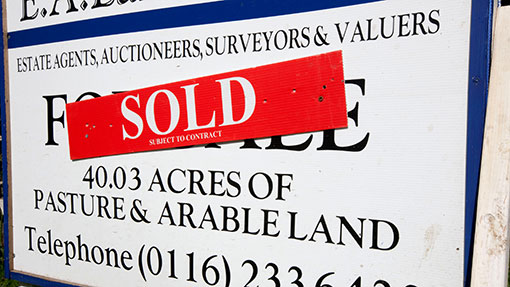Farmland values hit £10,000/acre for first time

Farmland values in England increased 6% in the past 12 months to break the £10,000/acre barrier for the first time, according to Smiths Gore’s second-quarter farmland market report.
The farmland value is the average price paid for advertised farmland including both bare land and “equipped land” – land with houses or buildings.
The value of bare land increased by 2% to hit £7,200/ acre, while the value of equipped land increased 2% to reach £11,000/acre.
A continued tight land supply and strong demand from both farmers and (increasingly) investors were driving up prices.
See also: Retirements bring more land to the market
The amount of land on the market in the second quarter of this year (April to June) was relatively static at 57,000 acres – just 1,000 acres (2%) more than at the same time last year.
However, since the beginning of 2014 about 7% less land came up for sale than in the first six months of last year – 68,200 acres compared with 73,500 acres.
“Demand from both investors and farmer buyers is supporting competition for land and driving capital growth,” said Giles Wordsworth, head of farms and estates at Smiths Gore.
“Investors continue to move their money into the ‘safe haven’ of farmland as an investment, with its obvious tax advantages, but farmers remain the dominant, if slightly more cautious, buyers.”
Values in Scotland, however, remained flat, said Savills, with the independence referendum and changes to agricultural land holdings and land reform leading to uncertainty.
Prime arable land in England increased to an average of £9,500/ acre, with the best sales achieving in excess of £12,000/acre, while prime arable land in Scotland reached an average £8,000/acre, hitting £9,000/acre for the best land.
“The Scottish farmland market is facing a completely different set of circumstances to the rest of the UK and, as we predicted, the resulting uncertainty has caused decisions by sellers to be put on hold,” said Charles Dudgeon, director of Savills’ Edinburgh office.
“Buyers are still very competitive where they see good value compared with the rest of the UK and where location fits their strategy for expansion/relocation”.
Both Savills and Smiths Gore predicted that as the economy picked up and generated more wealth generally, demand from non-farming investors was likely to strengthen. Meanwhile, farm incomes were likely to dampen due to expected interest rate rises. This was likely to bring more land to the market, but not enough to significantly pressure prices.
See also: Return on land reaches 12.3% on traditional estates
